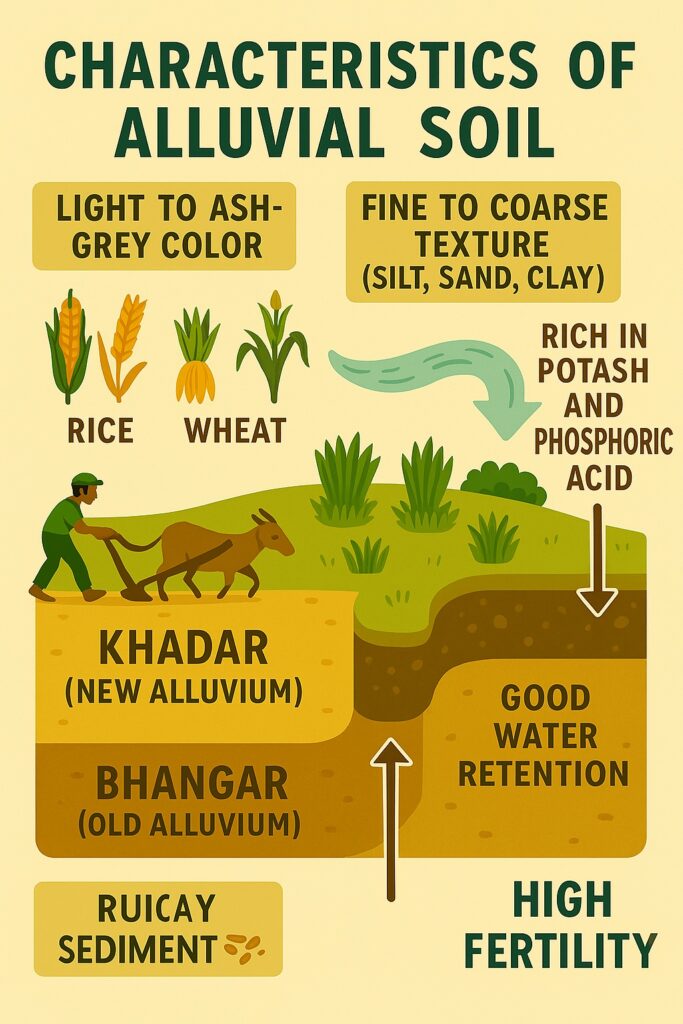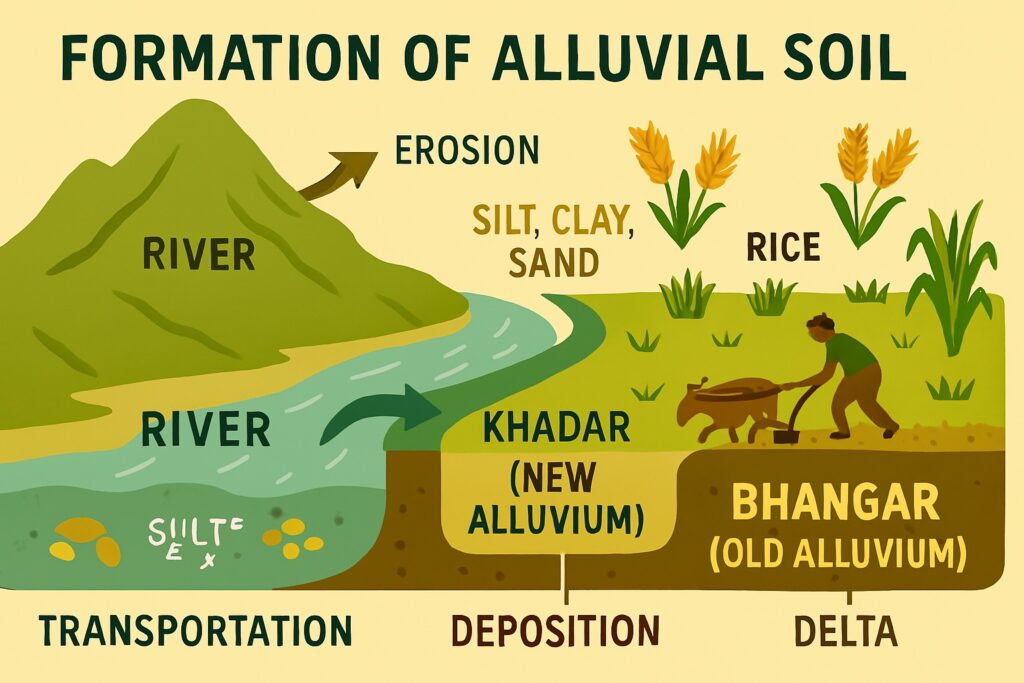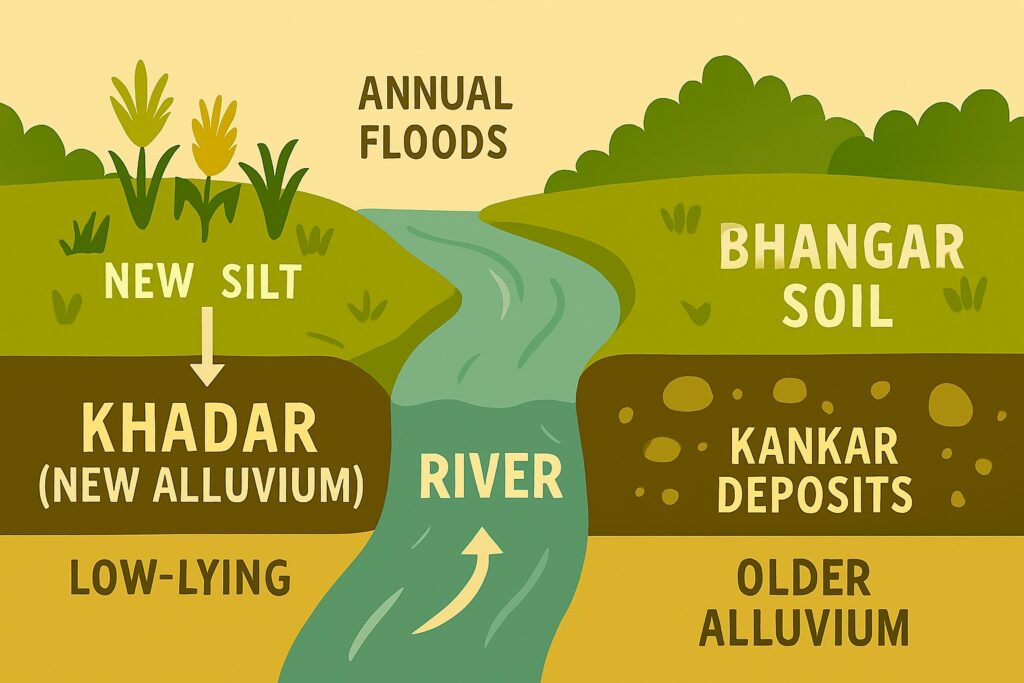Alluvial soil is one of the most fertile and widely distributed soil types, primarily found in river valleys, floodplains, and coastal regions. It is formed by the deposition of silt, sand, clay, and organic matter carried by rivers over time. This soil type is particularly significant for agriculture due to its rich nutrient content and excellent water retention capacity. Alluvial Soil is one of the most fertile types of soil found in India. It is formed by the deposition of silt and clay brought by rivers and streams from the mountains.

Table of Contents
Formation and Distribution of Alluvial Soil
Alluvial soil is created through the continuous deposition of sediments by rivers. It is commonly found in the Indo-Gangetic Plain, the Brahmaputra Valley, and the coastal regions of India. Globally, alluvial soil is present in major river basins such as the Nile, Amazon, and Mississippi.

Key factors in its formation
- Weathering of rocks in mountains (especially the Himalayas)
- Transportation of debris by rivers such as the Ganga, Yamuna, Brahmaputra, and their tributaries
- Deposition in low-lying plains and deltas due to reduced river velocity
Characteristics
- Texture: Varies from sandy to clayey, with a predominance of silt.
- Color: Ranges from light grey to ash grey.
- Fertility: Highly fertile due to the presence of minerals like potash and phosphoric acid.
- Stratification: Shows distinct layers due to periodic deposition by floods.
Types of Alluvial Soil
- Khadar Soil: Found in low-lying floodplains, enriched with fresh silt deposits annually.
- Bhangar Soil: Older alluvial soil, located above flood levels, often containing calcium carbonate nodules (kankars).

Types of Alluvial Soils
Distribution of Alluvial Soil in India
Alluvial soil covers approximately 40% of India’s land area, especially in the northern plains and coastal regions. Major regions include:
1. Indo-Gangetic Plain
-
States: Punjab, Haryana, Uttar Pradesh, Bihar, West Bengal
-
Rivers: Ganga, Yamuna, Ghaghara, Gandak, Kosi
-
Most fertile region of India
2. Brahmaputra Valley
-
State: Assam
-
Formed by sediments from Brahmaputra and its tributaries
3. Coastal Plains
-
States: Odisha, Andhra Pradesh, Tamil Nadu
-
Deltas of rivers like Mahanadi, Godavari, Krishna, and Kaveri
4. Western India
-
State: Gujarat
-
Found in river basins of Narmada, Tapi, Sabarmati, and Mahi
Alluvial soil covers around 40% of the total land area in India. It is mainly found in the northern plains, which include the states of Punjab, Haryana, Uttar Pradesh, Bihar, and West Bengal. The Ganga-Brahmaputra-Meghna river system is responsible for depositing it in these regions. The soil here is deep, well-drained, and rich in organic matter. It is also well-suited for the cultivation of crops such as wheat, rice, sugarcane, and cotton.
It found in the Indo-Gangetic plain is further divided into two types: Khadar and Bhangar. Khadar soil is formed by the deposition of new alluvium, which is brought down by floods every year. This soil is more fertile and suitable for growing paddy, wheat, maize, and vegetables. On the other hand, Bhangar soil is older alluvium that lies above the flood level. This soil is less fertile but is suitable for growing crops such as tobacco, jute, and mustard.
Apart from the northern plains, it is also found in the delta regions of the Godavari, Krishna, and Cauvery rivers in the southern part of India. The soil here is known for its high fertility and is suitable for the cultivation of rice, sugarcane, and other crops.
It is also found in the northeastern region of India, particularly in the valleys of the Brahmaputra and Barak rivers. The soil here is rich in organic matter and is suitable for the cultivation of tea, jute, and sugarcane.
Conclusion
In conclusion, alluvial soil is one of the most fertile types of soil found in India, and its distribution is mainly concentrated in the northern plains. However, it is also found in other parts of the country, such as the delta regions of southern India and the valleys of the northeastern region. Understanding the distribution and properties of alluvial soil is essential for successful agriculture in these regions.
Read: Geography Notes
